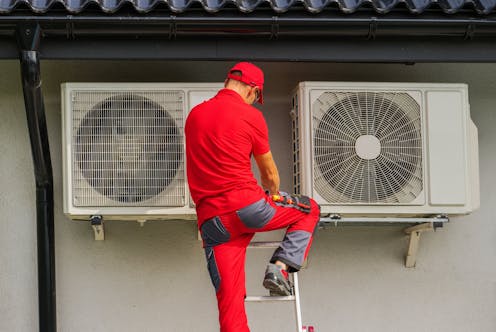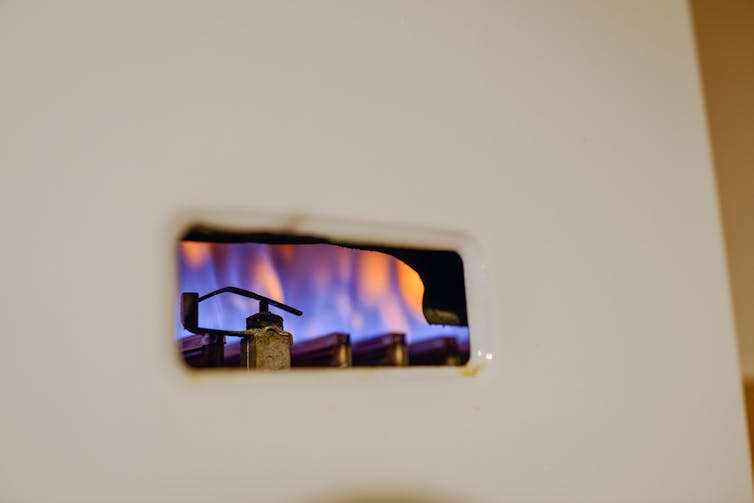
The UK’s housing stock is old, energy inefficient and heavily reliant on fossil fuel heating systems – mainly gas boilers. With heating responsible for 17% of the UK’s carbon emissions, homes and their central heating must transform if the country is to achieve net zero by 2050.
While there isn’t a single solution that will suit every home, government advisers on the Climate Change Committee (CCC) estimate that 8 million heat pumps need to be installed in existing homes by 2035.
The CCC recently published a damning assessment of the UK’s progress towards its 2030 climate goals, saying annual emission reductions outside the power sector must nearly quadruple. Home heating is of particular concern, as heat pumps are being rolled out at one-ninth the rate they need to be by 2028, alongside falling rates of energy efficiency improvements.
Heat pumps extract heat either from the air, ground or nearby water and transfer it into a building, providing heating and hot water through pipes and radiators. Some heat pumps can even work in reverse to cool homes during the summer.
Heat pumps run on electricity and use energy three times more efficiently than gas boilers.
Better still, UK homeowners are becoming more comfortable with this technology. A survey of 2,500 households in May 2023 revealed that more than 80% that had installed a heat pump were satisfied.

UK trails European neighbours
Only 59,862 heat pumps were installed in the UK in 2022. Although this is an increase of 40% on 2021, it’s far from the government’s target of 600,000 a year by 2028. To fully replace all of its gas boilers, the UK would need to be installing 1.7 million heat pumps annually by 2036.
Heat pumps are being rolled out faster elsewhere. In Norway, 60% of buildings have heat pumps; in Sweden, over 40%. Meanwhile, less than 1% of UK buildings had a heat pump in 2021. And compare the UK’s 2022 record with other countries in Europe: France installed 462,672 heat pumps (up 20%), Germany 236,000 (up 53%) and the Netherlands 123,208 (up 80%).
European governments support heat pump installations in various ways. The Netherlands has gradually raised taxes on homes burning natural gas for heating and offered subsidies for heat pumps. France has combined a 30% tax credit on improvements to heating and home insulation costing up to €16,000 with a 0% interest loan of up to €30,000 for energy efficiency upgrades.
These measures address two things which prevent people from getting a heat pump: the upfront cost of installation and the renovations required to prepare a home. Heat pumps are becoming cheaper but they are still more expensive than gas boilers and many UK homes lack the double-glazed windows, insulated walls and lofts, and pipework and radiators that help them perform optimally.

Since 2012, government policy has failed to drastically improve home energy efficiency or encourage low-carbon heating.
The carbon emissions reduction target introduced by Gordon Brown’s Labour government in 2008 required energy suppliers to cut emissions by helping customers make their homes more energy efficient. When it closed in 2012, it had beaten its target of saving 293 million tonnes of carbon dioxide. 41% of these savings came from installing insulation, in turn making homes more suitable for a heat pump.
The green deal followed in 2013 and the renewable heat incentive in 2014 under David Cameron’s Conservative-led coalition government.
Green deal loans for energy-efficiency upgrades attracted just 14,000 applicants as homeowners baulked at the relatively high cost of borrowing and were unconvinced by the projected energy savings. The scheme was scrapped in 2015.
The renewable heat incentive paid homeowners quarterly over seven years for installing a heat pump but asked them to fund the installation upfront. In 2018, the government blamed high upfront costs, poor awareness and complex installations for the poor uptake. The incentive ended in 2022.
Ban the boiler?
Launched in 2022 under Boris Johnson, the boiler upgrade scheme offers homeowners a £5,000 grant to replace their gas boiler with an air-source heat pump (£6,000 for a ground-source heat pump) and aims to lower the cost difference between the two. Installing a new combi-boiler costs between £600 and £2,150 whereas a heat pump is £5,000 to £8,000 after the government subsidy.
The government also plans to implement a clean heat market mechanism that will ask boiler manufacturers to sell four heat pumps for every 100 gas boilers in 2024/25, or pay for the equivalent in heat pump credits if they can’t (one heat pump credit is worth £5,000).
These measures may improve on earlier failures if the rules for industry are clear and the incentives are generous enough for consumers to consider investing in a heat pump, as examples with other low-carbon technologies have shown.
For instance, evidence suggests carmarkers are already selling more battery-electric vehicles in anticipation of a law requiring them to sell a rising proportion of zero-emission vehicles each year from 2024. And the feed-in-tariff scheme requiring energy suppliers to buy electricity from homeowners at an agreed price for 10 to 25 years helped nearly a million households install solar panels.
Beyond targets for boiler manufacturers, the UK government will ban natural gas boilers in new buildings from 2025. While Germany’s governing coalition is implementing a ban on installing gas boilers in existing properties from 2028.

Before such a ban is tabled in the UK, there are policies that could raise the dismal heat pump installation rate. First, like the Dutch, the UK could gradually lower taxes on residential electricity and increase them on gas.
Second, the government could ensure energy performance certificates more accurately assess the energy efficiency of homes and their readiness for heat pumps. And third, the government should dismiss opposition from boiler manufacturers and implement the clean heat market mechanism.
Decarbonising heat and encouraging heat pumps is essential for achieving net zero. Tighter rules and targets for industry must sit alongside attractive incentives for consumers if the UK is to reach 600,000 installations a year in five years’ time.

Don’t have time to read about climate change as much as you’d like?
Get a weekly roundup in your inbox instead. Every Wednesday, The Conversation’s environment editor writes Imagine, a short email that goes a little deeper into just one climate issue. Join the 20,000+ readers who’ve subscribed so far.
Ned Lamb is funded by the Engineering & Physical Sciences Research Council's Low Temperature Heat Recovery and Distribution Network Technologies (LoT-NET) programme.
This article was originally published on The Conversation. Read the original article.







